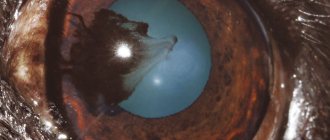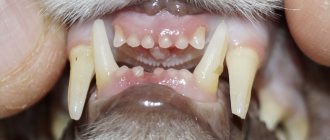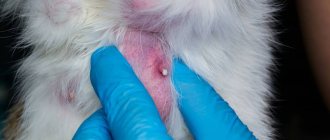Pets are susceptible to illnesses just like people. Eye disease in cats is common. Responsibility for the health of the pet lies with the person. The owner’s task is to recognize the signs of pathology in time and contact a veterinarian. The doctor will conduct an examination, make a diagnosis and prescribe treatment. You cannot ignore the symptoms and hope that the disease will go away on its own. Lack of timely treatment leads to deterioration of vision, extensive inflammation and blindness.
Classification of eye pathologies in cats
Veterinarians divide all eye diseases into 2 groups: inflammatory and non-inflammatory. The classification is based on the causes and characteristics of pathological processes. Each group is characterized by certain risk factors. The course of therapy is selected taking into account the type of pathology.
The most common inflammatory diseases include:
- blepharitis;
- conjunctivitis;
- keratitis;
- panophthalmitis;
- keratoconjunctivitis.
The group of non-inflammatory diseases includes:
- bruises;
- foreign body entering the eye;
- glaucoma;
- prolapse of the eyeball;
- entropion of the eyelid;
- cataract.
The course of the disease is chronic, acute and subacute. At first, the symptoms appear vividly. If therapy is not used for a long time, the disease enters the chronic stage. The absence of obvious signs does not mean that the animal has recovered. At any moment, chronic pathology can worsen.
Eye diseases in cats are primary and secondary. This is the main criterion by which veterinarians select a therapeutic course. Primary pathology is the main one, secondary is a consequence of another disease. The main goal of treatment is to eliminate the underlying disease. Sometimes the cause of chronic inflammation of the eye mucosa is infection or helminthic infestation. In this case, therapy is aimed at combating pathogenic microorganisms and helminths.
Causes
Veterinary experts distinguish 2 main categories of causes of eye diseases:
- Disturbances in the functioning of protective organs and the eyeball itself. These include various injuries and burns, inversions and eversion of the eyelids, fusion and drooping of the eyelids, eye loss, blepharitis, neoplasms;
- Pathology of the organ of vision itself. These are: glaucoma, cataracts, conjunctivitis, keratitis, iritis, panophthalmitis, uveitis, etc.
All of them require urgent veterinary care, as they can become chronic, which is either very difficult to treat or incurable, and the organ will have to be removed.
Keratitis: manifestations, types and therapy
Cats lead an active lifestyle. If an animal goes outside for a walk, the risk of corneal injury increases. In the future, the situation is complicated by the addition of infection. Keratitis develops - inflammation of the cornea. The disease is severe. The cat's eyes hurt, itch and water. The animal becomes restless and cries often.
The following symptoms indicate the presence of keratitis in cats:
- Increased secretion of fluid from the eyes. In this way, the body gets rid of the infection.
- Fear of light. If the affected cornea is exposed to direct sunlight, the cat hides in a dark place.
- Discharge of pus. If an infection occurs, white or yellow pus oozes from both eyes.
- Lack of shine and clouding of the cornea. The surface of the visual organ takes on a gray tint.
If keratitis is not treated, the cat will soon develop conjunctivitis. Pathogenic microorganisms are actively multiplying. Extensive inflammation develops, affecting both organs of vision. Veterinarians call this pathology keratoconjunctivitis. If competent medical care is not provided in time, the pet may die.
In modern veterinary medicine, there are the following types of keratitis:
- purulent;
- non-purulent;
- deep;
- surface.
The cat must be shown to a doctor. The doctor will determine whether there is a foreign body in the eye. If present, it is removed. The damaged eye is washed with furatsilin solution. Xeroform ointment is placed into the conjunctival sac. Iodine-based preparations are effective.
If keratitis is caused by infection, then the eyes are treated with an antiseptic solution. Mercury ointment is placed behind the eyelid. To relieve inflammation and boost immunity, veterinarians advise using aloe-based medications. Warming compresses should be used carefully and only with the permission of a doctor. Otherwise, the inflammation may worsen.
Eyesore
Syphilis
Herpes
12812 August 17
IMPORTANT!
The information in this section cannot be used for self-diagnosis and self-treatment.
In case of pain or other exacerbation of the disease, diagnostic tests should be prescribed only by the attending physician. To make a diagnosis and properly prescribe treatment, you should contact your doctor. An eyesore: causes of occurrence, what diseases it occurs with, diagnosis and treatment methods.
Definition
An eyesore, or leukoma, is externally manifested by clouding of the cornea of the eye that occurs after injury or an inflammatory process. The cornea is the anterior, most convex part of the eye capsule, consisting of a thin avascular membrane through which refracted light enters the posterior parts of the eye. There are three stages of corneal opacification depending on the size and depth of the lesion: a cloud, a spot and a cataract, but all of them affect visual acuity, and in some cases a person can become completely blind in the affected eye.
The success of treatment largely depends on timely seeking medical help.
Types of eyesores
There are congenital and acquired eyesores:
- congenital cataract is formed during the period of intrauterine development of the embryo and is often combined with other congenital eye diseases;
- the acquired form is the most common, occurring equally often in both men and women.
Depending on the depth of the lesion, the following types of cataracts are distinguished:
- corneal cataract without affecting other parts of the eye; there are scars of different shapes and lengths in the cornea;
- a thorn welded to the iris; a cloudiness appears on the cornea, sprouting with small vessels, spreading to the area of the iris;
- a cataract in combination with true clouding of the lens, that is, cataract;
- cataract with secondary cataract;
- intense clouding of the cornea of the eye, which is characterized by adhesions of the cornea with the iris and/or lens, clouding of the lens;
- a thorn complicated by retinal detachment and the development of eye atrophy.
Possible causes of eyesores
Doctors consider keratitis, an inflammation of the cornea of the eye, to be one of the possible causes. The most common cause of keratitis is a viral infection (herpes viruses, chickenpox). Often, bacterial infections, as well as non-compliance with the rules of wearing contact lenses, lead to an inflammatory process in the cornea.
Keratitis is characterized by redness of the eye, pain, lacrimation, photophobia, clouding of the cornea already in the initial stages of the disease, and decreased visual acuity.
If treatment is not started on time, the inflammation will spread deeper and an eyesore will begin to form.
Corneal injuries are another common cause of eyesores. Injuries can be mechanical, thermal or chemical (alkali or acid burns). Alkaline burns are the most dangerous.
The first symptoms of injury are pain, lacrimation, sensation of a foreign body, drooping of the eyelid.
Any injury to the cornea requires immediate medical attention.
Infectious diseases of the conjunctiva can lead to damage to the cornea and the appearance of a cataract. The conjunctiva is the connective membrane of the eye that covers the inner surface of the eyelids and extends from the outside to the cornea. One of the most dangerous diseases of the conjunctiva is trachoma. It occurs when a chlamydial infection enters the eye, is chronic and causes blindness in almost two million people in the world. Children are most susceptible to this eye disease.
Tuberculosis is an infectious disease that, despite the successes of domestic medicine, is still often diagnosed in patients of all ages. Tuberculosis can affect any organs and systems of the body, including the infection that can spread to the eyes, lead to deep damage to the cornea and cause the formation of a cataract.
Cases of cataract formation after eye surgery have been described. This is due to a violation of the integrity of the cornea, which increases the risk of infection.
Diseases leading to the formation of eyesores
- Congenital pathologies, for example, limbal dermoid, sclerocornea.
- Keratitis.
- Injuries (chemical, thermal burns, penetrating wounds).
- Trachoma.
- Corneal ulcers.
- Tuberculosis, syphilis.
Which doctors should you contact if an eyesore appears?
An ophthalmologist deals with the treatment of eyesores. He will order tests and conduct additional examinations. If you suspect an infectious etiology of the cataract, you may need to consult an infectious disease specialist or phthisiatrician.
Diagnostics and examinations for the appearance of an eyesore
To clarify the diagnosis, the doctor may prescribe the following examinations:
- a clinical blood test with a detailed leukocyte formula will help identify inflammatory changes in various infectious and inflammatory diseases;
Blepharitis: causes, manifestations and treatment methods
Outdoor and indoor cats are susceptible to inflammation of the eyelids. This disease is called blepharitis. The pathology is rapidly worsening. In the absence of timely treatment, blepharitis turns into panophthalmitis. The advanced stage of the disease often causes the loss of one or both eyes.
Veterinarians identify the following causes of blepharitis:
- staphylococcal or streptococcal infections;
- seborrhea;
- fungal lichen;
- subcutaneous mites;
- helminths;
- endocrine disorders;
- autoimmune diseases;
- allergy;
- eye wounds;
- salivary gland duct transplantation.
Symptoms and treatment are closely related. Therapy is prescribed taking into account the type and manifestations of the pathology. Blepharitis occurs:
- Scaly. This is the most common type of illness. The cat's eyelids turn red, swell and become dense. Purulent scales form near the eyelashes. Later the hairs fall out.
- Ulcerative. This form of pathology develops if scaly blepharitis is not treated in time. The crusts fall off and open wounds appear on the eyelids. Infection penetrates into them, inflammation occurs. The eyelid rolls up and pus begins to flow out of the eyes.
- Meibomiev. The lower part of the eyelid becomes dense and thick. The meibomian glands secrete pus. The cat cannot close his eye completely.
With blepharitis, cats' eyes become itchy and painful. You should contact the clinic immediately after detecting the first symptoms. The main task of the veterinarian is to identify and eliminate the cause of the pathology. If an infection is present, the cat is prescribed antibacterial therapy and immunoglobulins. When the disease is caused by a tick, therapy is delayed for several months. For prevention purposes, it is recommended to give the cat an antiparasitic agent.
It is difficult to get rid of lichen. If blepharitis appears precisely because of it, then the veterinarian prescribes long-term complex treatment. The cat is vaccinated, the surface of the body is treated with special antifungal ointments. Sometimes antibiotics are injected into the conjunctival cavity. This should only be done by a doctor. Many medications are prescribed to destroy the infection as quickly as possible.
Treatment
Most eye diseases are treated conservatively. To do this, use various drops and ointments containing antibacterial agents. Before placing or instilling them, wash the animal’s eyes with a weak solution of furatsilin or potassium permanganate.
The most popular are products based on Tetracycline, Gentamicin, Erythromycin and Levomycetin.
They try not to use Albucid to treat pets, as it burns strongly and the animal will not allow it to be instilled anymore.
After applying the ointment or drops, you should hold the cat in your arms for a while, otherwise it will wipe off all the medicine with its paw.
If there was an injury, Solcoseryl ointment (Actoveginovaya) helps well for healing; it is applied to the inside of the eyelid.
In advanced stages, antibiotics are administered intramuscularly or intravenously, depending on the condition of the animal and the tolerability of the procedure.
In order to exclude allergies to injected drugs, a course of antihistamines, for example, Suprastin or Tavegil, is prescribed.
They try to resort to surgical treatment in extreme cases or when it is not possible to preserve the organ of vision. For example, with panophthalmitis, this is often the only treatment option.
Conjunctivitis in cats
The eyeball and eyelids are covered on top with a thin mucous membrane - the conjunctiva. It contains the ducts of the lacrimal glands, which perform protective and cleansing functions. One of the most common eye diseases in cats is conjunctivitis, an inflammation of the mucous membrane of the eyelids. This disease manifests itself as follows:
- increased tear secretion;
- eyelids become red and swollen;
- the animal is afraid of light;
- the eye becomes cloudy and loses its shine;
- eyelids turn out;
- movements of the eyeballs are impaired.
There are such types of conjunctivitis:
- Catarrhal. This form of the disease is easy to treat. Catarrh is mucus discharged from the eyes. Body temperature rarely rises.
- Purulent. The presence of this type of disease is indicated by yellow or green discharge from the eyes. After sleep, the cat's eyelids stick together and dry yellow crusts appear.
- Phlegmonous. This form is difficult. Pus accumulates not only outside, but also in the internal structures of the eye. It is necessary to immediately contact a veterinarian.
- Follicular. Lymphatic follicles are damaged. They become inflamed and bulge outward. In this case, only surgery to remove the follicles can help.
The main causes of feline conjunctivitis are viruses, fungi and bacteria. Even pets come into contact with pathogenic microorganisms every day. Infections are brought into the house with shoes, outerwear, umbrellas, bags, and so on. The disease occurs due to allergies. Cats are often diagnosed with intolerance to certain foods. Strong allergens are: dust, indoor plants and plastic products (food bowls, toys, trays).
Conjunctivitis can appear due to mechanical damage to the mucous membrane. A wound is a potential breeding ground for infections. If your cat has injured his eye, you should immediately show it to a veterinarian. Contact with household chemicals also harms the eyes. Vapors of bleach, acetone, and grains of washing powder cause burns to the mucous membrane, which can subsequently lead to blindness.
Inflammation of the mucous membrane of the eyelids is often parasitic in nature. Therefore, the animal must be treated for helminths. Therapy depends on the cause of the disease. It is necessary to exclude allergens and treat the eye with antiseptic drugs. The course of treatment is prescribed by the veterinarian after examining the cat.
Keratitis - inflammation of the cornea
The causes of keratitis can be:
- mechanical influences;
- infectious diseases: calcivirus,
- toxoplasmosis.
There are two types of keratitis:
- superficial - only the outer epithelial layer is affected;
- deep - the process extends to the corneal parenchyma.
Both types can be accompanied by purulent discharge.
The symptoms of the onset of the disease are quite clear:
- lacrimation;
- the palpebral fissure is half-closed;
- the cornea begins to become cloudy, and with further development of the inflammatory process, the clouding intensifies;
- redness of the conjunctiva.
This is what the initial stage of keratitis may look like
If keratitis does not have complications, then the transparency of the cornea will be restored, otherwise a thorn will form on the eye.
When providing first aid, it is necessary to rinse the conjunctival sac with a disinfecting solution. To prepare it you can use:
- boric acid: half a teaspoon of powder is dissolved in one glass of cold boiled water;
- furatsilin: 0.2 g of powder per liter of warm water;
- herbal remedies: 1 tsp. chamomile or calendula is brewed with half a glass of boiling water, then cooled.
If there is pus, it must be completely removed from the eyelashes so as not to contribute to the spread of infection. The swab is moistened with a disinfectant solution and applied to the eye to soften the purulent crusts. Then the eyelids are cleaned.
Video: how to put drops in a cat’s eyes
Washing of the conjunctival sac is carried out according to the following scheme:
- the lower eyelid of the animal is slightly retracted;
- a solution is instilled into the opened cavity;
- the eyelid is released, the skin under it is lightly massaged;
- excess moisture is removed with a swab.
After this, you can treat the cornea with eye drops or hydrocortisone ointment. But the full course of treatment is prescribed only by a doctor after an accurate diagnosis has been established.
Video: what to do if a kitten’s eye is cloudy
Panophthalmitis - serious damage to the entire eye
There are many eye diseases in cats, the treatment of which must be quick and timely. Otherwise, serious complications develop, one of which is panophthalmitis. The disease affects all eye tissues. It is rarely recorded. Panophthalmitis progresses rapidly. Within a month, the cat loses not only its vision, but also its eye as a whole. To prevent a fatal outcome, you need to urgently seek help from a veterinarian.
Symptoms of panophthalmitis are:
- swelling and redness of the eye;
- discharge of pus;
- eversion of the eyelid;
- inability to fully open or close the eye;
- growth of yellow crusts on the eyelids;
- eyelash loss;
- increased body temperature;
- convulsions.
If the diagnosis of panophthalmitis is confirmed, the veterinarian removes the affected eyeball. The eyelids are stitched together. This is necessary so that inflammation does not affect the brain. If you refuse the operation, the cat will die.
Panophthalmitis is not an independent pathology. The disease develops due to prolonged lack of therapy for keratitis, blepharitis, conjunctivitis, and so on. If your cat's lacrimation increases, you should contact a professional veterinary clinic. A timely diagnosis facilitates therapy and speeds up recovery. Ignoring the symptoms can result in the loss of an eye or the death of your pet.
Symptoms of cataracts
The second most common disease is cataracts. As a result of natural aging or various metabolic processes in the body, clouding of the lens occurs.
- A cloudy lens is unable to perform its main function - accommodation of the eye.
- A specific symptom that should alert a cat owner is the appearance of shine in the eyes.
At the same time, the pet also squints, trying to reflexively increase visual acuity.
The photo of this eye disease shows a pronounced clouding of the eyeball, which every owner will notice.
Non-inflammatory pathologies: cataracts and glaucoma
The animal suffers from various visual impairments, just like humans. Cats often have: strabismus, glaucoma or cataracts. Strabismus is only an external defect that does not interfere with the pet’s life. Cataracts and glaucoma are serious pathologies that can cause a cat to lose vision or the entire eyeball. A competent therapeutic course will save your cat from blindness.
A cataract is a clouding of the lens. Most often it appears in animals over 7 years of age. The pathology may be congenital. Sometimes cataracts develop as a result of infection or prolonged inflammation. The main symptom of the disease is deterioration of the cat’s vision. The pet bumps into objects and moves slowly and carefully. Cats with cataracts have difficulty navigating new terrain. The eye gradually becomes cloudy and a white spot appears. In the initial stages, cataracts are treated with medication. The medications are prescribed by a veterinarian. In advanced cases, the doctor performs surgery.
Glaucoma is a disorder of the drainage of fluid from the eyes. The disease is caused by increased intraocular pressure. Veterinarians distinguish 3 types of feline glaucoma: congenital, open-angle and closed-angle. Each form requires a different approach to treatment. Symptoms of the disease are:
- enlargement of the eyeball;
- pupil dilation;
- the appearance of hemorrhages on the conjunctiva;
- corneal clouding;
- lethargy and restless behavior of the animal.
Glaucoma is accompanied by pain in the eyes and head. The cat needs to be taken to the vet immediately. The doctor will determine the type and degree of the disease. In most cases, therapy consists of taking pills or using eye drops. If the cause of glaucoma is lens luxation, the doctor will prescribe surgery.
Eye diseases in cats can be successfully treated in the early stages. Resorting to traditional medicine is not recommended. This can provoke the development of life-threatening complications for the pet. If suspicious symptoms are detected, you should immediately take your cat to the veterinarian. The doctor will provide qualified assistance, and the animal will quickly return to its previous life without pathology.
Symptoms of glaucoma
The second group of eye pathologies includes non-infectious diseases of the organ of vision. The most common manifestation is glaucoma. Due to congenital or acquired narrowing of the chambers of the eye, the outflow of fluid is disrupted, pain attacks develop and visual acuity decreases.
Signs of glaucoma in a pet include:
- Pupil dilation.
- Loss of response to light stimulus.
- When visual acuity changes, the pet begins to squint.
- Violation of the trophism of the tissues surrounding the eyes leads to a decrease in the size of the fatty tissue of the orbit. Externally, you can notice the retraction of the eyeball.
In the first stages of the disease, injection of the sclera is noted, and then the front of the eye gradually acquires a dark tint.
Prevention of blepharitis
Proper nutrition and an active lifestyle strengthen the animal’s body. To boost immunity, it is useful to give vitamin and mineral supplements.
Try to protect your pet from contact with stray and sick animals. Wash your hands when coming from outside. Put outer clothing and shoes in the closet (they can bring infection into the house).
Animal Eye Problem? How to treat?
Drafts and prolonged hypothermia have an adverse effect (especially on kittens). A healthy cat does not need to clean or rinse its eyes, but it is important to monitor their condition regularly. If a cat's eyelid becomes inflamed, this is a reason to immediately contact a veterinarian.
All information posted on the site is provided in accordance with the User Agreement and is not a direct instruction to action. We strongly recommend that before using any product, you must obtain a face-to-face consultation at an accredited veterinary clinic.
Blepharitis - inflammation of the eyelid
The first signs of blepharitis disease are redness and thickening of the conjunctiva. Inflammation may be accompanied by the release of pus, mucus, the appearance of bleeding ulcers, and severe lacrimation. If left untreated, the inflammatory process spreads to nearby organs.
The causes of blepharitis are different:
- mechanical eye injury or burn (thermal or chemical);
- manifestation of allergies to medications or food;
- fungal or bacterial infection;
- parasite infection.
To treat blepharitis, even at the initial stage, it is not enough to relieve the inflammatory process, since it is necessary to determine the initial cause of the disease, and this can only be done by a qualified specialist.
Blepharitis is often confused with conjunctivitis, but they are different diseases and require different treatments.
Diagnostics in a veterinary clinic
Diagnosis of the disease includes taking an anamnesis, examining with a slit lamp, studying clinical signs, and the necessary laboratory tests (washes, scrapings, blood tests, biopsy of eyelid tissue). It is important to differentiate blepharitis from other ophthalmological pathologies and to identify the factor that provoked a decrease in immunity.











